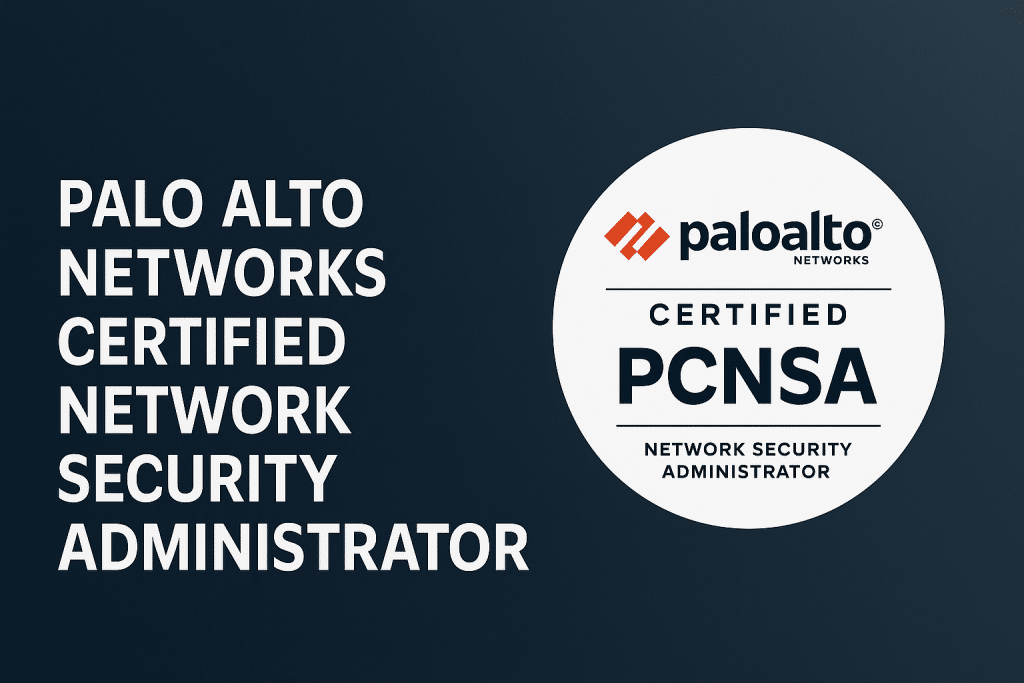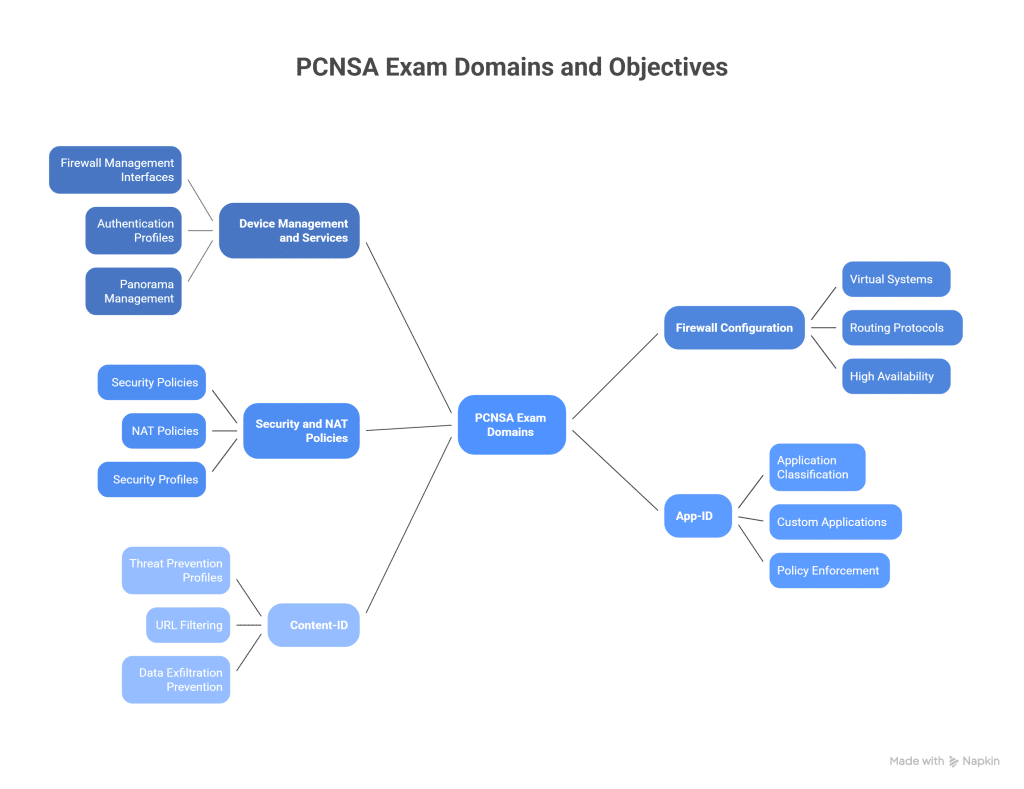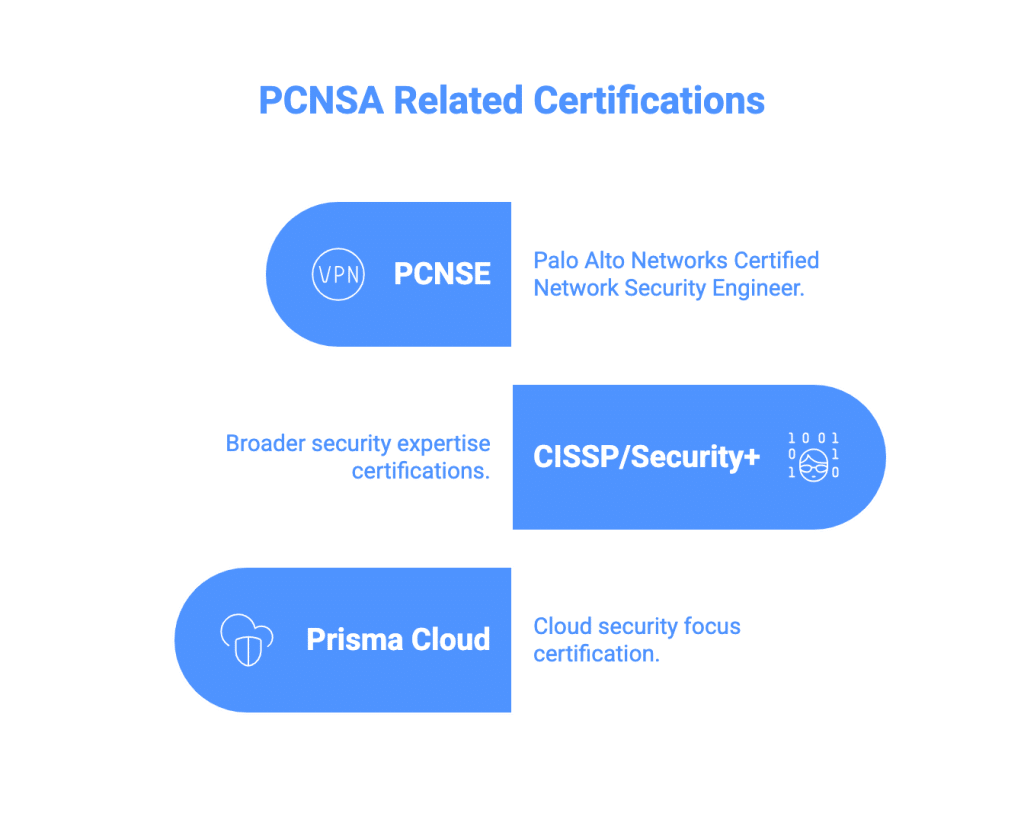
What is PCNSA Exam?
The Palo Alto Networks Certified Network Security Administrator (PCNSA) validates the ability to deploy and operate Palo Alto Networks next-generation firewalls. Candidates demonstrate skills in core firewall configuration, traffic management, VPN setup, and basic security policies. It is a globally recognized entry-to-mid level cybersecurity credential focused on real-world network security administration.
Who should take this exam
Palo Alto Networks Certified Network Security Administrator (PCNSA) suits:
- Network Security Administrators and Analysts managing Palo Alto firewalls
- System or Support Engineers providing security solutions
- IT and SOC Team Members seeking a first Palo Alto certification
Typical experience: 6 months to 2 years of hands-on work with firewalls or security appliances.
Prerequisites and recommendations
Official prerequisites: None.
Practical recommendations:
- Prior certifications like CompTIA Security+ or PCNSE EDU-110 training are helpful.
- Familiarity with networking (IP addressing, routing, NAT)
- Knowledge of basic cybersecurity concepts (threats, malware, access control)
- 6+ months managing Palo Alto Networks devices
Exam objectives and domains
The current PCNSA exam is organized into these main domains:
- Palo Alto Networks Security Operating Platform and Architecture
- Initial Configuration and Device Management
- Security and NAT Policies
- Application and Content ID
- User Identification and Authentication
- Monitoring, Reporting, and Logging
- Securing Remote Access (VPN)
- Managing Subscriptions and Updates

Objective details by domain
1. Security Operating Platform and Architecture
- Understand next-generation firewall architecture
- Describe key components like Panorama and WildFire
- Explain App-ID, Content-ID, and User-ID concepts
2. Initial Configuration and Device Management
- Register, license, and upgrade firewalls
- Configure interfaces, zones, and virtual routers
- Manage admin roles and authentication profiles
3. Security and NAT Policies
- Create and validate security rules
- Configure source and destination NAT
- Apply rulebase best practices
4. Application and Content ID
- Control traffic with App-ID
- Use Content-ID for threat prevention
- Configure URL filtering and file blocking
5. User Identification and Authentication
- Set up User-ID agents
- Integrate with directory services
- Configure multifactor authentication
6. Monitoring, Reporting, and Logging
- View traffic and threat logs
- Generate custom reports
- Set log forwarding profiles
7. Securing Remote Access (VPN)
- Configure site-to-site and GlobalProtect VPNs
- Troubleshoot VPN connectivity
8. Managing Subscriptions and Updates
- Schedule updates and manage licenses
- Manage threat, URL, and WildFire subscriptions
What changed in this version
- Cloud-focused features: Coverage of Prisma Access basics and new GlobalProtect options
- Updated interface tasks: Reflects PAN-OS 11.x
- Shift in weighting: More emphasis on automation, dynamic updates, and App-ID tuning
- Some legacy CLI-only topics removed.
Registration and scheduling
- Register through Pearson VUE online or at test centers.
- Exam delivery: on-site or online proctored.
- Choose date, time, and language (English, Japanese, etc.).
Pricing and vouchers
- Standard fee: $155 USD (may vary by country).
- Regional taxes apply.
- Discounts:
- Students and faculty via Palo Alto Networks Academic Program
- Corporate or bulk vouchers for teams
- Occasional promotions during cyber-awareness months
Policies you should know
- Retake allowed after 15 days if failed.
- Must present government-issued ID.
- No reference materials or electronic devices allowed.
- Reschedule or cancel at least 48 hours in advance.
Scoring and results
Scoring scale: 200–800 points
Passing score: 70% (around 700 points)
No partial credit per question
Immediate pass/fail at test end
Official score report emailed within 24 hours.
Exam day and test experience
On-site: Arrive 30 minutes early, bring ID. Lockers provided.
Online proctoring: Check webcam, room scan required.
Time limit: 90 minutes for about 50–60 questions.
Tips: Read all questions once, flag doubtful ones, manage time (about 1.5 minutes per question).
Study plan and resources
A balanced plan depends on your background.
Beginner (6–8 weeks)
- Weeks 1–2: Palo Alto EDU-110 course, read PCNSA study guide
- Weeks 3–4: Lab practice in Panorama or virtual firewall
- Weeks 5–6: Take official practice exams and focus on weak domains
- Week 7: Daily review, flashcards, final mock exam
Experienced (3–4 weeks)
- Week 1: Quick syllabus review, identify weak topics
- Week 2: Targeted labs and configuration tasks
- Week 3: Practice exams and timed sessions
- Week 4: Final adjustments and rest before exam
Suggested resources:
Official practice tests and community study groups
Palo Alto PCNSA Study Guide and EDU-110/210 courses
Hands-on practice with PAN-OS 11.x
Certification validity and renewal
Valid for 2 years.
Renewal by retaking the PCNSA exam or earning the higher-level PCNSE certification.
Career outcomes
PCNSA holders commonly work as:
- Network Security Administrator
- Firewall or Security Operations Engineer
- SOC Analyst
Typical salary range in the U.S. is $80,000–$115,000 depending on role and region.
| Job Role | Typical Responsibilities | Average Annual Salary (USD) |
|---|---|---|
| Network Security Administrator | Deploy and maintain Palo Alto firewalls, manage policies, monitor threats, respond to incidents | $80,000 – $100,000 |
| Firewall Engineer / Palo Alto Engineer | Advanced firewall configuration, VPN setup, troubleshooting complex issues, implementing updates | $90,000 – $115,000 |
| Security Operations Center (SOC) Analyst | Monitor alerts, investigate incidents, escalate threats, work with SIEM and firewall logs | $75,000 – $95,000 |
| IT Security Specialist | Broad IT security duties including firewall management, endpoint security, vulnerability remediation | $85,000 – $110,000 |
| Network Engineer (Security Focus) | Design secure network architectures, integrate Palo Alto firewalls into LAN/WAN environments | $90,000 – $120,000 |
| Cloud/Network Security Engineer | Secure hybrid or cloud networks, configure cloud-delivered security (Prisma Access) | $95,000 – $125,000 |
| Information Security Analyst | Risk assessment, policy enforcement, compliance audits, and firewall rule reviews | $80,000 – $105,000 |
Related or next-step certifications
PCNSE (Palo Alto Networks Certified Network Security Engineer)
CISSP or CompTIA Security+ for broader security expertise
Prisma Certified Cloud Security Engineer for cloud security focus

How this exam compares to similar certifications
Compared to CompTIA Security+, PCNSA is more product-specific and hands-on.
Compared to Cisco CCNA Security, PCNSA focuses exclusively on Palo Alto next-generation firewalls and threat prevention.
Ready to master the PCNSA exam with confidence? Visit Cert Empire now to access our exclusive PCNSA PDF questions, meticulously crafted to mirror the real exam format and content. Jump-start your prep with real-life scenarios, sharpen your skills, and verify your readiness with our practice questions. Don’t just study, certify your expertise!
Get the PCNSA PDF Dumps on Cert Empire.
Frequently Asked Questions (FAQs)
How long does it take to prepare for the PCNSA exam?
Preparation time depends on your starting point. If you are new to Palo Alto firewalls, plan about 6–8 weeks with steady practice labs and mock exams. Experienced network or security engineers who work with Palo Alto devices every day can be ready in about 3–4 weeks by focusing on weaker areas and doing a few timed tests.
Is PCNSA really entry-level or more intermediate?
PCNSA is often described as entry-level to mid-level. It is accessible to newcomers who understand basic networking but also has enough depth to challenge working security administrators. Think of it as the first serious Palo Alto credential that proves you can deploy and manage their next-generation firewalls in production.
Does the PCNSA certification expire?
Yes. PCNSA is valid for two years. You can renew by retaking the current PCNSA exam or by earning a higher Palo Alto Networks certification such as PCNSE, which automatically extends your PCNSA status.
What is the passing score and how is it reported?
The exam uses a 200–800 scoring scale, and a passing score is around 700. Your unofficial pass/fail result appears on the screen as soon as you finish. A detailed, official score report with domain-by-domain performance arrives by email within 24 hours.
Can I retake the exam if I don’t pass?
Yes. You can retake after 15 days if you do not pass. There is no penalty or limit, but you must pay the exam fee for each attempt.
What is the exam format like?
Expect about 50–60 multiple-choice and matching questions in 90 minutes. The test is available online with remote proctoring or in a Pearson VUE testing center. You must present valid government ID and follow proctor instructions.
Can I use books or notes during the test?
No. PCNSA is a closed-book exam. All notes, electronic devices, and printed materials must be stored away or removed from the room.
What happens if I lose internet during an online proctored exam?
Pearson VUE’s proctoring software will attempt to reconnect automatically. If the connection can’t be restored quickly, you can reschedule at no additional cost by contacting Pearson VUE with the incident report.
How much does the PCNSA exam cost worldwide?
The standard price is about USD $155, but exact fees vary slightly by region due to taxes or currency exchange. Palo Alto occasionally offers discount vouchers for students, veterans, or corporate training programs.


